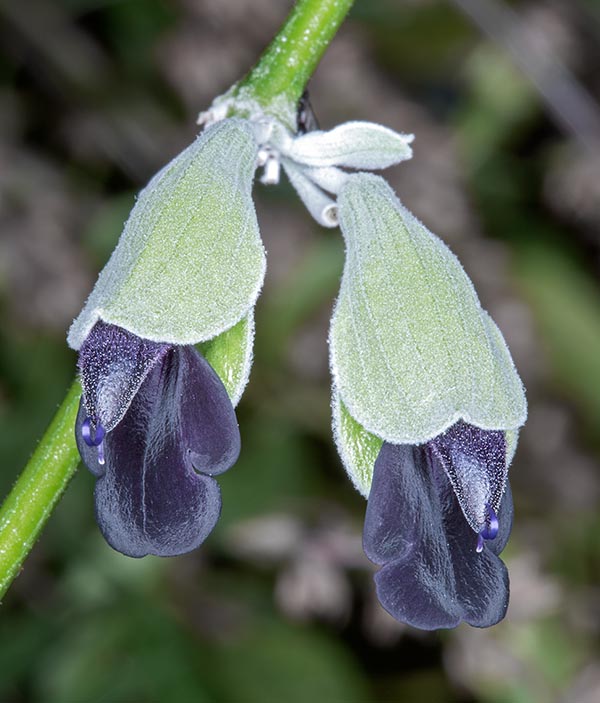Family : Lamiaceae

Text © Pietro Puccio

English translation by Mario Beltramini

Native to the Peru mountains, where is pollinated by hummingbirds, the Salvia discolor is a species rare in nature and in cultivation that should deserve a better diffusion in the horticultural world © G. Mazza
The name of the genus is the Latin one that should come after some from the verb “salvo” = to save, to heal, after others from “salveo” = to feel good, both related to the Sanskrit “sarvas” = to save, with refrence to the medicinal properties; the specific name is the Latin adjective “discolor, oris” = of different colour, with reference to the difference of colour between the upper page and the lower one of the leaves.
Common names: Andean sage, Andean silver-leaf sage, black sage, Peruvian sage (English); sauge du Pérou, sauge andine, sauge cassis, sauge noire (French); yatoma (Peru); Peruanischer Salbei (German).
The Salvia discolor Kunth (1818) is a perennial, sarmentose shrub, evergreen, very ramified at the base, 40-90 cm tall, with tetragonal stems covered by whitish tomentum except in the young branches. The leaves, on an about 1,6 cm long petiole covered by white tomentum, are simple, opposite, ovate-lanceolate with pointed apex and entire margin, of intense green colour and glabrous above, covered by whitish tomentum below, aromatic, 4-8 cm long and 2-4 cm broad.
Terminal inflorescences, 20-25 cm long, with groups of semi-pendant flowers, on short peduncle, 2-3 cm long, arranged on the rachis in rather spaced verticils, that emit an intense aroma; the rachis is sticky because of the presence of glands on which often remain stuck small insects.
Bilobed campanulate calyx covered by a white greenish tomentum, upper ovate lip with pointed apex, bidentate lower lip. Corolla of blackish violet colour, entire upper lip; trilobed lower one with longer median lobe. The flowers, rich of nectar, attract several insects and in the origin site are pollinated by hummingbirds. They have selected a variety, Salvia discolor ‘Purple Bracts’, with calyx suffused with purple and of a more contained size. It reproduces by seed, division in spring, herbaceous cutting in spring and semi-woody in summer in draining loam maintained humid; the cuttings emit the roots also in water.

Sticky aromatic leaves and unusual nectariferous blackish blue flowers © Giuseppe Mazza
Rare in nature and in cultivation it should deserve a greater diffusion due to the particularly ornamental and aromatic foliage and the inflorescences with unusually coloured flowers.
Almost continuous blooming in the tropical and subtropical climate zones, and from spring to the first cold days in the temperate-warm ones, where it can stand temperatures up to about -4 °C without significant damage to the aerial part, even some grade less if maintained dry.
It forms flowerbeds and borders even mixed, of impressive effect, requires full sun for a good part of the day or partial shade, in particular in the warmer and drier climates, and light soils, deep and well drained, slightly acidic to slightly alkaline.
Well rooted plants can resist to long periods of drought, but they grow best if watered regularly during the warmest months, but without stagnations that may aver detrimental to the rooting apparatus.
Periodical prunings and fertilizations contribute in keeping a compact shape and a luxuriant vegetation. Cultivable as annual, where the climate does not allow the continuous permanence in open air, sowing in a protected environment in winter and trasferring out in late spring.
Excellent subject to cultivate in pot, even suspended, for the decoration of open spaces as well as of greenhouses and winter gardens in the less favourable climates, where it can bloom sporadically also in winter.
It is subject to the attack of numerous parasites, especially in closed areas, it is therefore to be controlled frequently in order to be able to intervene promptly with specific products.
Synonyms: Salvia bonplandiana F.Dietr. (1821); Salvia mexicana Hemsl. (1883); Salvia nigricans Hemsl. (1883).
→ To appreciate the biodiversity within the family LAMIACEAE please click here.
